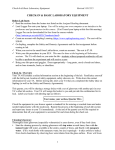Download Database Analyzer User Manual
Transcript
Database Analyzer User Manual Title Database Analyzer User Manual File Name Database Analyzer 5.3 Category Data Profilers, Data Modeling, Code Generators Version 5.3 Author Malloc Inc. Contact [email protected] Last Updated Tuesday, November 30, 2010 Database Analyzer 5.3 Database Analyzer version 5.3 Table of Contents Database Analyzer version 5.3 ....................................................................................................................... 1 Table of Contents ............................................................................................................................................. 1 Description ....................................................................................................................................................... 2 Benefits ............................................................................................................................................................ 2 Compatibility ..................................................................................................................................................... 3 Running Database Analyzer as a Batch Process ............................................................................................ 3 Installation ........................................................................................................................................................ 4 Running Database Analyzer ............................................................................................................................ 5 Configuration ................................................................................................................................................ 6 Connection to the database .......................................................................................................................... 7 Sample Connections..................................................................................................................................... 8 Oracle ........................................................................................................................................................ 9 Sybase ...................................................................................................................................................... 9 MS Access ................................................................................................................................................ 9 MS SQL Server ....................................................................................................................................... 10 DB2 ......................................................................................................................................................... 10 Downloading JDBC Drivers ........................................................................................................................ 10 Troubleshooting Database Connection Problems .................................................................................. 10 Analysis Tab ............................................................................................................................................... 12 Volumetrics: ............................................................................................................................................ 12 Constraints: ............................................................................................................................................. 12 Sample Data: .......................................................................................................................................... 12 Target Objects ............................................................................................................................................ 13 Analyze database objects by name ............................................................................................................... 13 Creating Reports ............................................................................................................................................ 13 Analyze database objects by type .................................................................................................................. 16 Analyze specific database object‟s features .................................................................................................. 16 Warnings ........................................................................................................................................................ 16 Special features .............................................................................................................................................. 16 Reports ........................................................................................................................................................... 17 Report sections ........................................................................................................................................... 18 Basic database server features .............................................................................................................. 18 Database Server limitations .................................................................................................................... 19 Creating ordered tables lists .......................................................................................................................... 25 Appendix A – Test Data Model ........................................................................................................................ 1 Page 1 of 27 Database Analyzer 5.3 Description DB Analyzer is a tool that helps you analyze database server, database structure and data. The following analysis can be performed: - database server features - database structure (catalogs, schemas, tables, views, columns, constraints) - data (sample data, cardinality, occurrence, etc.) - relationships between database tables DB Analyzer is designed to help IT personnel such as business analysts, managers, architects, developers, administrators to better understand how and what data is stored in the database. It gives a huge jumpstart during the data conversion, data mapping, system development, optimization, troubleshooting and in any task where good understanding of the database and the data is required. Benefits DB Analyzer analyzes database structure and data. This particular feature distinguishes this software from CASE tools such as Erwin and Power Designer where you can analyze structure of the database but not the data. Page 2 of 27 Database Analyzer 5.3 DB analyzer is not to meant to replace CASE software but to be used in addition or as stand alone software depending on the type of the user. For example: Business analyst might be interested in what data is stored in certain tables and columns – what is really stored in field BOND_DESC? Developer might be interested in format of data – does the phone number have spaces, dashes, brackets? Database administrator is interested number of records in database tables so he can do the proper sizing of the database. Data architect is interested in data duplication so he can determine degree of model normalization, utilization of the space – why filed declared as CHAR(100) has only „Y‟ and „N‟ values, etc. QA analysts can check the quality of test bed database and ensure the data is sufficiently diversified and appropriate for user acceptance testing. System architect might be interested in available database features - All this information can be obtained by typing SQL commands however that required skills and it is tedious and error prone. DB analyzer produces consolidated and convenient way to exploit this information at your fingertips. Compatibility GUI User interface is running on Windows 2000/XP/Vista/Windows 7. It can also run on X Windows and MAC OS however these distributions are not supported. The following databases are supported Oracle DB2 Sybase Microsoft SQL Server Microsoft Access Other databases that support JDBC interface - contact Malloc Inc for demo. Running Database Analyzer as a Batch Process Database Analyzer can run from command line as a batch process (without GUI interface) on Windows and UNIX. This method is convenient for scheduling longer processes. Sample script demonstrates how you can run Database Analyzer in the background process. Process will continue running even if you logout from the system. Page 3 of 27 Database Analyzer 5.3 Installation Installation of the Database Analyzer is simple and does not require a special privileges on your computer. Also, no changes to the registry file are made so installing it will not affect performances of your computer. Un-installation is as simple as removing the directory where “Database Analyzer” is installed. 1. Create a directory where you would like to install Database Analyzer, for example “C:\DBA” 2. Download “Install Database Analyzer 5.3.exe” to some temporary location on your disk. This is installation program that can be deleted after installation is completed. 3. After download is complete execute “Install Database Analyzer 5.3.exe” 4. Program will ask you about the location where you want “Database Analyzer” to be installed. Choose directory you created in step #1 (C:\DBA) –see picture below. 5. Installation process will look something like this: 6. When installation process finishes you can start application by running “C:\DBA\Database Analyzer 5.3\Database Analyzer 5.3.exe” (see screens below) Page 4 of 27 Database Analyzer 5.3 Running Database Analyzer Page 5 of 27 Database Analyzer 5.3 Database Analyzer front end interface is divided into seven screens (tabs): 1. Configuration 2. Connection 3. Analysis 4. Target Objects 5. Output 6. Settings 7. Code Generator Configuration When you start Database Analyzer the first screen (tab) to be displayed will be Configuration” Configuration files have extension “cfg” and they keep all information about certain analysis such as : Database connection parameters What needs to be analyzed What kind of reports should be produced Code generator parameters Location of the analysis files Page 6 of 27 Database Analyzer 5.3 When you specify these parameters in Database Analyzer front end application you can save them for future use by clicking on the “File” and either “Save” or Save As”. There is no option “New” to create new configuration file. Instead you would open existing, probably similar configuration file, make changes and then use option “Save As” to create new configuration file. Configuration files can be edited manually in the editor however it is better to do it in the Database Analyzer. The easiest way to clone configuration file is to open exiting, similar file, make desired changes and then use “Save As” option under “File” menu to save it under different name. Connection to the database Database Analyzer use JDBC standard to connect to the database. Application includes drivers for: 1. Oracle 2. DB2 3. Sybase SQL 4. Microsoft SQL Server Page 7 of 27 Database Analyzer 5.3 These drivers are proprietary software of the database vendor. This software is always available for free download from the vendor‟ and in general, the newest version should be used. Creating connection goes as follows: 1. Choose appropriate driver. 2. Once driver is chosen, Database Analyzer will examine the file and it will offer all possible “Driver Classes” that could be used. Choose the one you want to use. 3. Select Database Vendor 4. Type in “Database Url” according to JDBC standard (some samples for different database vendors are provided below). 5. Connection description is a free form text that will appear on the reports and it is used to distinguish particular database connections. 6. Enter username and password. 7. Use push button “Test Connection” to make sure that information entered is correct. Sample Connections See this link! http://e-docs.bea.com/wli/docs81/rdbmseg/intro.html Page 8 of 27 Database Analyzer 5.3 Oracle http://www.oracle.com/technology/software/tech/java/sqlj_jdbc/htdocs/jdbc_10201.html jdbc:oracle:thin:@server_name:port:service_name o o o server_name – name of the server machine where database server is running. This can be IP address of the server as well. If your environment is not configured properly the only way to connect to your database may be by using IP address instead of server name. port – network port where database listener is active service_name – Oracle service name on the server identified by “server_name”. It is usually the same as instance name. Examples: jdbc:oracle:thin:@production:1521:oraprd jdbc:oracle:thin:@134.66.25.121:1521:oraprd Sybase Setting character set example: jdbc:sybase:Tds:server_prod:4500?CHARSET=iso_1 If database character set is roman8 or older version: jdbc:sybase:Tds:todev108:4500?CHARSET=iso_1&CHARSET_CONVERTER_CLASS=com.sybase.jdbc2. utils.TruncationConverter Refer to Sybase JDBC documentation for more information on JDBC parameters. Example: jdbc:sybase:Tds:server_prod:777 MS Access Example: jdbc:odbc:DATA_SRC1 Page 9 of 27 Database Analyzer 5.3 “DATA_SRC1” is data source name configured in “ODBC” configuration MS SQL Server jdbc:microsoft:sqlserver://<host_name>:<port_number>;DatabaseName=<database_name>. However, if Other Driver was selected from JDBC driver pull-down list, then the Connection URL field is enabled allowing you to either type or select the appropriate URL connection. DB2 jdbc:db2://<host_name>:<port_number>/<database_name> (where <database_name> is the name of database name that you provided in step Downloading JDBC Drivers Database Oracle 10g Release 2 Driver File ojdbc14.jar Troubleshooting Database Connection Problems If you get the following message when you test your database connection then you should fix that problem before proceeding with database analysis: Check all entices that you made in `Connection` screen. If you cannot see the problem that you have an option to look at the detailed Database Analyzer log file: Page 10 of 27 Database Analyzer 5.3 c:\DBA\Database Analyzer 5.3\log\dbadministrator.log In this file you may find message that looks something like this: 2010-11-29 14:28:51,045 ERROR [main] DatabaseConnectionFactory -> SQLException: Failed to connect to "Database "RETAIL" on AIX server "Tower"" 2010-11-29 14:28:51,045 ERROR [main] DatabaseConnectionFactory -> Stack trace: [Ljava.lang.StackTraceElement;@1db6942 2010-11-29 14:28:51,045 ERROR [main] DatabaseConnectionFactory -> Error message: Io exception: The Network Adapter could not establish the connection 2010-11-29 14:28:51,045 ERROR [main] DatabaseConnectionFactory -> Error code: 17002 This particular error indicates data database is not available on this IP address and port and you should verify this information with your Database Administrator. Page 11 of 27 Database Analyzer 5.3 Analysis Tab In this section user can decide what database features will be analyzed. Volumetrics: Number of records in the table Constraints: Sample Data: Records – amount of sample data to be retrieved from the database Binary Data Size – Text Data Size - Page 12 of 27 Database Analyzer 5.3 Target Objects Analyze database objects by name Creating Reports There are three report layouts: 1. Classic Report 2. Continuous Report 3. Relationship Report Page 13 of 27 Database Analyzer 5.3 Sample data is included in report and is ordered by occurrence in that particular field. Page 14 of 27 Database Analyzer 5.3 Page 15 of 27 Database Analyzer 5.3 Analyze database objects by type Analyze specific database object’s features Warnings o o o There is no PK in table PK is not mandatory field Table is orphan Special features o o Database analysis starts from the point where it was stopped even if system crashes. Application can be terminated at any given moment either on purpose by clicking the process or because of the system failure. In any case database analysis will continue from the point of failure meaning that it will not need to recreate information that was made before the moment of failure. Also, binary files are usable even if database analysis is not continued. They can be used to produce reports as well as DAO code, however those would be produced only for tables analyzed before the point of the failure. Page 16 of 27 Database Analyzer 5.3 Reports All reports produced in HTML format and can be opened in all popular browsers. Reports are also editable – they can be imported in for example MS Word where file can be converted in different format, including Microsoft “.doc” format. Once HTML file is imported into Word, user can add footers, headers, page number, select paper orientation and basically use any MS Word feature to make document look like any other company document. Some examples are provided below. Special features: o reports can be opened in any browser, no need for specialized software to read reports o reports are editable o provide information about database structure and the data o provide warnings and suggestions about possible improvements of the data model o easy to produce o available in three different formats with options to include or exclude sections of the report Sample MS Word Documents. Classic report provides information about database server, databases (Sybase and MS SQL Server support multiple databases under the same database server), schemas, tables and views, columns and data. Continuous report provides the same information as Classic report however in format which is suitable for adding new columns in the document. This is particularly handy when user wants to put some additional information such as data transformation rules in case of a mapping document. Relationship report provides information about referential integrity in the database. On that report user can see what Primary Key columns are referenced by what foreign key columns and vice versa. Some popular data modeling tools cannot give information about parent columns so this feature is a great addition to Case tools. Common sections in all reports: o o o o o o o o Basic database server features Database server limitations Database server supporting features List of databases Detailed tables information List of schemas in database selected to be analyzed List of tables in databases and schema selected to be analyzed Detailed columns information section (at the end of the document) Page 17 of 27 Database Analyzer 5.3 Report sections Basic database server features Page 18 of 27 Database Analyzer 5.3 Database Server limitations Page 19 of 27 Database Analyzer 5.3 List of schemas in database selected to be analyzed Page 20 of 27 Database Analyzer 5.3 Database server supporting features Page 21 of 27 Database Analyzer 5.3 Data duplication CURRENCY_CODE and DESCRPTIONS have same values and it is very likely that one of these columns is redundant. Data Dispersion Verify if data dispersion is as expected. For example, “ON” appears fifty times more than any other STATE. “Canada” and “US” are the only countries in the COUNTRY field and first one much more frequent. CURRENT_ADDRESS_IND has exactly 50% of “Y” and “N” – how likely is to have that split? Modeling Issues - Primary Keys Warnings in RED color are shown in case that table probably requires immediate attention. In this case table is missing a Primary Key and it is very likely that model needs to be verified and corrected. Also, table does not have any records and maybe business logic has to be verified to confirm if this table is in fact required. Page 22 of 27 Database Analyzer 5.3 Detailed column information This is optional section in the report. It provides detailed information about database table columns. Particularly useful is “Constraint Information” about the referenced column and rules associated to the behavior enforced by the constraint (update and delete rule and well as deferability). Many ERD tools will not be able to provide this information. Note that the table name is an active link which you can use to quickly go back to the table detail section. Data Anomalies For this associative table data sample reveals possible data anomaly - all items are associated only to one transaction. Page 23 of 27 Database Analyzer 5.3 Table information Detailed table information Space for additional information such as user‟s comments, mapping information and transformation rules. Column names are active links to detailed column information section Sample data ordered by occurrence gives insight to the content of the column. Column data type, Primary Key sequence number, nullability, true data uniqueness and cardinality. Referential Integrity This report gives you information about relationships defined between database tables. You can see what columns are referencing table‟s Primary Key and what Primary Keys are referenced by table‟s Foreign Keys. Note that all table and column name fields are active links. Page 24 of 27 Database Analyzer 5.3 Creating ordered tables lists This feature is used to produce ordered table list depending on relationship between tables. For example if you want to drop table by table you would use this method to create list of tables ordered in the way tables can be dropped, meaning that tables with no children will be dropped first. This method creates another list with the reverse order from the list created by method "getOrderedTableList". For example, this option can be used to create tables. File “C:\Temp3\ordered_list.sql” will be created with the following content (see data model on next page): drop drop drop drop drop drop drop drop drop drop drop drop drop drop drop drop table table table table table table table table table table table table table table table table TRANSACTION_ITEM; USER_PROFILE; CURRENCY_CODE; ROLE_PERMISSION; PERMISSION; USER_ROLE; ROLE; PAYMENT; PAYMENT_INSTRUMENTS; LOGIN_HISTORY; TRANSACTION; USERS; PERSON; ORGANIZATION; ADDRESS; ITEM; Note that database views are ignored when orderd tables list is created. Page 25 of 27 Database Analyzer 5.3 Appendix A – Test Data Model Table with the VARCHAR field as a primary key Address Address Id Street Building Number Unit City Postal Code ZIP State Country Current Address Ind Orphan Table INTEGER <pk> not null VARCHAR(100) not null INTEGER null INTEGER null VARCHAR(40) not null CHARACTER(7) null INTEGER null VARCHAR(50) null VARCHAR(40) not null CHAR not null Organization ORGANIZATION HAS ADDRESS Organization Name VARCHAR(50) <pk> not null Address Id INTEGER <fk> not null Industry VARCHAR(50) not null Organization Size VARCHAR(20) null International CHAR null Table with too many columns in primary key Currency Code Currency Code CHAR(3) <pk> not null Description VARCHAR(50) not null Active Ind CHAR not null Permission System Id Module Id Window Id Function Id Permission Type INTEGER INTEGER INTEGER INTEGER VARCHAR(10) <pk> <pk> <pk> <pk> <pk> not not not not not null null null null null PERSON MAY BELONG TO ORG Tables "Users" and "User Profiles" have a mandatory "one to one" relatioships so they are good candidates for merge into a single table. PERSON MAY HAVE ADDRESS Person User Profile Person Id INTEGER <pk> Organization Name VARCHAR(50) <fk1> Address Id INTEGER <fk2> First Name VARCHAR(30) Last Name VARCHAR(40) Date of Birth DATE Created DATE Modified DATE not null null not null not null not null null not null null Profile Id INTEGER <pk> not null User Id INTEGER <fk> not null Profile Name VARCHAR(50) not null User Role User Id INTEGER <pk,fk1> not null Role Id INTEGER <pk,fk2> not null Active Ind VARCHAR(1) null PERM ARE ASSIGNED TO ROLES Table without primary key Role_Permission USER MAY HAVE ROLES USER HAVE A PROFILE Role Id System Id Module Id Window Id Function Id Permission Type USER IS ASSOCIATED TO PERSON ROLES MAY BE ASSOC TO USER Users Login History Login History Id User Id Login Datetime Logout Datetime INTEGER <pk> not null INTEGER <fk> not null DATE not null DATE null USER HAS LOGIN HISTORY User Id Person Id Username Password Active Ind INTEGER <pk> not null INTEGER <fk> not null VARCHAR(50) not null VARCHAR(50) not null CHAR not null Item INTEGER <pk> not null VARCHAR(50) not null VARCHAR(50) null INTEGER not null DECIMAL(10, 2) not null DECIMAL(10, 2) null CHAR not null not not not not not not null null null null null null Role Role Id Role Name Grantable Active Transaction Item Id Item Name Item Description Stock Quantity Price Buy Price Sell On Promotion Ind <fk1> <fk2> <fk2> <fk2> <fk2> <fk2> ROLE HAS PERMISSIONS USER HAS TRANSACTIONS Transaction Id User Id Amount Transaction Date INTEGER INTEGER INTEGER INTEGER INTEGER VARCHAR(10) INTEGER <pk> not null VARCHAR(50) not null CHAR null CHAR null Payment Instruments Paument Instrument Id INTEGER <pk> not null Payment Instrument Name VARCHAR(50) not null Payment Instrument Number NUMERIC null INTEGER <pk> not null INTEGER <fk> not null DECIMAL(10, 2) not null DATE not null PMT IS MADE BY PAYMENT INSTR TRANSACTION_HAS PAYMENTS TRANSACTION HAS TRANS ITEMS Payment TRANS ITEMS ARE IN TRANSACTION Transaction Item Transaction Id INTEGER <pk,fk2> not null Item Id INTEGER <pk,fk1> not null Quantity INTEGER not null Payment Id INTEGER <pk> Paument Instrument Id INTEGER <fk1> Transaction Id INTEGER <fk2> Dollar Amount DECIMAL(10, 2) not not not not null null null null User_Role_VW USERNAME ROLE_NAME Page 1 of 27












































